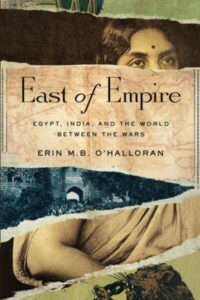While war is a perennial subject for historians, stories of friendships and exchanges, especially when set aside in the dustier corners of contemporary memory, make equally memorable material for history. A case study is the story of India and Egypt, the subject of East of Empire: Egypt, India, and the World between the Wars in which Erin MB O’Halloran recounts the relationship between the leaders and movements of the two countries between 1919 and 1939, a particularly interesting period that witnessed events such as the abolition of the Caliphate, the Abyssinian crisis, and the partition of Palestine.
South Asians and Egyptian Arabs had a lot in common: they were victims or subjects of the British Empire, Egypt a strongly-controlled protectorate and India a colony.Both were critical to the Empire: India may have been the Jewel in their Crown, but Egypt, and the Suez Canal specifically, was a crucial artery—or perhaps the jugular vein—for trade moving goods—and soldiers—from one place to another, much faster and cheaper than previously been the case. Such conditions facilitated an awareness between India and Egypt about the shared history of subjugation and gave rise to some form of solidarity.
Egyptian and Indian leaders were friends.

Egyptian and Indian leaders were friends, inspired by each other. Both Tagore and Gandhi visited Egypt. Tagore was received with a grand welcome in 1926; O’Halloran narrates how Tagore left his audiences in Alhambra Theatre in Alexandria spellbound. But his point is larger, of which Tagore is only an example, albeit the most visible or best documented:
Tagore was part of a broader, highly idealistic postwar wave of artists, authors, poets, and creatives whose work fused elements of spirituality, Eastern culture, internationalism, and anticolonialism in the decade after World War I. Combined with the national mass movements of 1919-24 and the multiplication of Islamic imaginaries that attended the dissolution of the Caliphate, this cultural milieu nurtured a new level of popular awareness, elite interaction, and intellectual exchange between Egyptians and Indians. The men and women who animated the “poetic” East not only perceived multiple levels of connection between their countries; they also worked to enhance these bonds, forging relationships across a space that they called Sharq, Orient, or East.
In contrast to Tagore, Gandhi did not technically visit Egypt. In 1931, he was on the SS Rajputana bound for London and undertook a short journey up the Suez Canal, which made headlines:
Among the flurry of articles that appeared the next was an exclusive interview with al-Ruh al-Azim (literally “Great Soul,” the Arabic translation of the Mahatma), conducted by Mahmud Abul Fat’h of al-Abram, who had boarded the SS Rajputana at Suez. Asked to impart some wisdom to the Egyptian nation, “Gandhi replied that true freedom did not come just from imitating the West. Noting that the Egyptians were also an ancient race, he said that he expectedIndia’s freedom to lead to Egypt’s as well, and that achieving this through nonviolence would have a great effect on all Eastern nations.”
Egypt and India stood against Italy’s invasion of Abyssinia in 1936.
The 1936-39 Arab Revolt in Palestine against the British Mandate was supported in both India and Egypt. The 1938 Cairo Conference received attendance from India’s Muslim League.
Egypt and India stood against Italy’s invasion of Abyssinia in 1936, with Nehru and Indian poet Iqbal among the voices O’Halloran records as examples of voices from India. However, there were differences too: Mussolini, through his propaganda machine such as Radio Bari, worked to deflate anti-Italy sentiment by drawing attention to the British treatment of Indian Muslims, projecting himself as pro-Muslim and anti-British. In Egypt, the Wafd chose not to make any strong statements and focus instead on their own internal affairs of gaining independent identity for the country, ridding itself of the veiled protectorate.
The Abyssinian Crisis prompted many Egyptians and Indians to embrace the Ethiopians as Eastern brothers. There were also, however, small yet ambitious minorities in both countries who saw in Mussolini’s fascist regime a model for their future independence – or at least a natural ally in their struggle against Great Britain. In this sense, the crisis of 1935 was a vivid harbinger of things to come.
The question of religious and political authority of Islam was another point of divergence between Egypt and India. More than a decade ago, in 1924, when the Caliphate was abolished, India launched the Khilafat movement: Indian Muslims were upset about the loss of an Islamic centre. However, the Egyptians, as Arabs, did need their Islamic identity validated by an external, especially Ottoman authority.
Moments of storytelling help the reader zoom in.
The book is a maze: for every historical event to make sense, one has to navigate a wide range of Egyptian and Indian “characters” and related events and background, a lot of which can extends back to the 19th century. The complexity of the subject also makes the book more dense and less quotable in terms of argument, though there are moments of storytelling that help the reader zoom in:
On the morning of 9 March 1919, an Egyptian lady awoke, as she did most mornings, in the beautiful house at Number Two, Qasr al-Nil – one of Cairo’s grandest boulevards. Huda Shaarawi was a self-possessed woman of forty, wealthy, elegant, and impeccably educated. It was early spring, the first since the armistice that had ended World War I. The first when one might dare to believe that the nightmare was finally over.
As O’Halloran gets to politics, things get progressively less visual and systematic. However, despite the challenges the book poses to the non-specialist reader not a specialist, it nevertheless illustrates the history of South-South friendships that may come as news to many. Nehru-Nahas and Tagore-Shawqi are among memories of friendships lost in an intervening period that included the Cold War, or the rise of China and the Gulf. The recent visit of the Indian Prime Minister to Egypt has been positioned as invigorating the trade relations between the two countries but this longer history of dialogue needs to be rediscovered through a contemporary lens.


You must be logged in to post a comment.